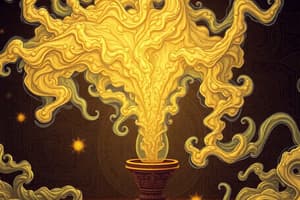Podcast
Questions and Answers
Which state of matter has molecules that are tightly packed and do not move?
Which state of matter has molecules that are tightly packed and do not move?
- Gas
- Plasma
- Solid (correct)
- Liquid
Which of the following laws states that the volume of a gas is inversely proportional to its pressure at constant temperature?
Which of the following laws states that the volume of a gas is inversely proportional to its pressure at constant temperature?
- Amonton's Law
- Avogadro's Law
- Charles's Law
- Boyle's Law (correct)
What is the formula for calculating pressure in a gas?
What is the formula for calculating pressure in a gas?
- P = V/T
- P = F/A (correct)
- P = nRT/V
- P = V/nRT
At what temperature does 0 °C correspond in Kelvin?
At what temperature does 0 °C correspond in Kelvin?
What is the relationship defined by Avogadro's Law?
What is the relationship defined by Avogadro's Law?
Which device is used to measure gas pressure?
Which device is used to measure gas pressure?
In the Ideal Gas Law, what does 'R' represent?
In the Ideal Gas Law, what does 'R' represent?
What is the relationship between the molecular speed and the pressure of a gas according to the kinetic theory of gases?
What is the relationship between the molecular speed and the pressure of a gas according to the kinetic theory of gases?
What happens to the volume of a gas when the temperature is increased at constant pressure?
What happens to the volume of a gas when the temperature is increased at constant pressure?
Which gas law relates pressure and volume of a gas at a constant temperature?
Which gas law relates pressure and volume of a gas at a constant temperature?
What does the formula PV = nRT represent?
What does the formula PV = nRT represent?
In the Ideal Gas Law, what is the value of 1 mole of gas at standard temperature and pressure?
In the Ideal Gas Law, what is the value of 1 mole of gas at standard temperature and pressure?
Which of the following correctly describes the density relationship of states of matter?
Which of the following correctly describes the density relationship of states of matter?
What is the primary function of a barometer?
What is the primary function of a barometer?
According to the kinetic theory of gases, what happens to gas molecules as temperature increases?
According to the kinetic theory of gases, what happens to gas molecules as temperature increases?
What is the relationship defined by Gay-Lussac's Law in terms of gas volumes?
What is the relationship defined by Gay-Lussac's Law in terms of gas volumes?
Flashcards
Ideal Gas Law
Ideal Gas Law
Combines Boyle's, Charles's, and Avogadro's Laws. Relates pressure (P), volume (V), number of moles (n), gas constant (R), and temperature (T) of a gas.
Boyle's Law
Boyle's Law
At constant temperature, the volume of a gas is inversely proportional to its pressure.
Charles's Law
Charles's Law
At constant pressure, the volume of a gas is directly proportional to its temperature (in Kelvin).
Avogadro's Law
Avogadro's Law
Signup and view all the flashcards
Gas Density
Gas Density
Signup and view all the flashcards
Gas Properties
Gas Properties
Signup and view all the flashcards
Gas Pressure
Gas Pressure
Signup and view all the flashcards
Standard Temperature and Pressure (STP)
Standard Temperature and Pressure (STP)
Signup and view all the flashcards
States of Matter
States of Matter
Signup and view all the flashcards
Density of Matter
Density of Matter
Signup and view all the flashcards
Pressure of Gas
Pressure of Gas
Signup and view all the flashcards
Kinetic Theory of Gases
Kinetic Theory of Gases
Signup and view all the flashcards
Study Notes
Physical Chemistry
- States of Matter: Solid, liquid, gas. Density increases in the order: Gas < Liquid < Solid. Water (H₂O) is an example, existing as solid (ice), liquid (water), and gas (steam).
- Gases: Characterized by:
- Taking the shape of their container.
- Mixing uniformly.
- Being easily compressed.
- Having a lower density compared to liquids and solids.
- Pressure: Force per unit area exerted by a gas on the walls of its container.
- Units of Pressure:
- 760 mmHg = 1 atm (standard atmospheric pressure).
- Measuring Pressure: Use barometers and manometers.
Gas Laws
- Boyle's Law: At constant temperature, the volume of a gas is inversely proportional to its pressure (P₁V₁ = P₂V₂).
- Charles' Law: At constant pressure, the volume of a gas is directly proportional to its absolute temperature (V₁/T₁ = V₂/T₂).
- Combined Gas Law: Combines Boyle's and Charles' laws, relating pressure, volume, and temperature in a gas (P₁V₁/T₁ = P₂V₂/T₂).
- Avogadro's Law: Equal volumes of different gases at the same temperature and pressure contain equal numbers of molecules.
- Ideal Gas Law: Relates pressure (P), volume (V), number of moles (n), and absolute temperature (T) of a gas (PV = nRT) where R is the ideal gas constant.
Dalton's Law of Partial Pressures
- The total pressure of a mixture of gases is equal to the sum of the partial pressures of the individual gases in the mixture. (Ptotal = PA + PB + ...).
Studying That Suits You
Use AI to generate personalized quizzes and flashcards to suit your learning preferences.




